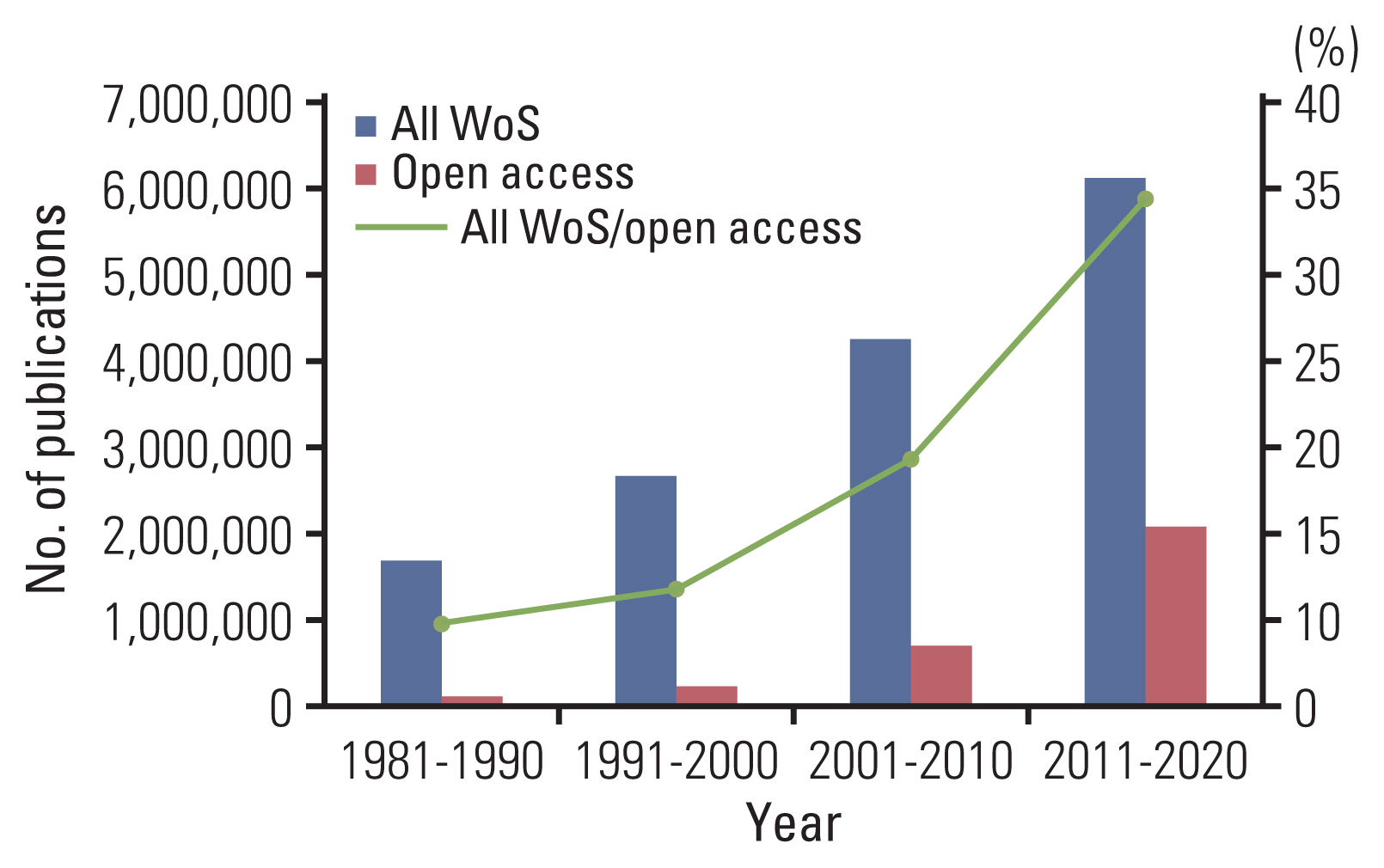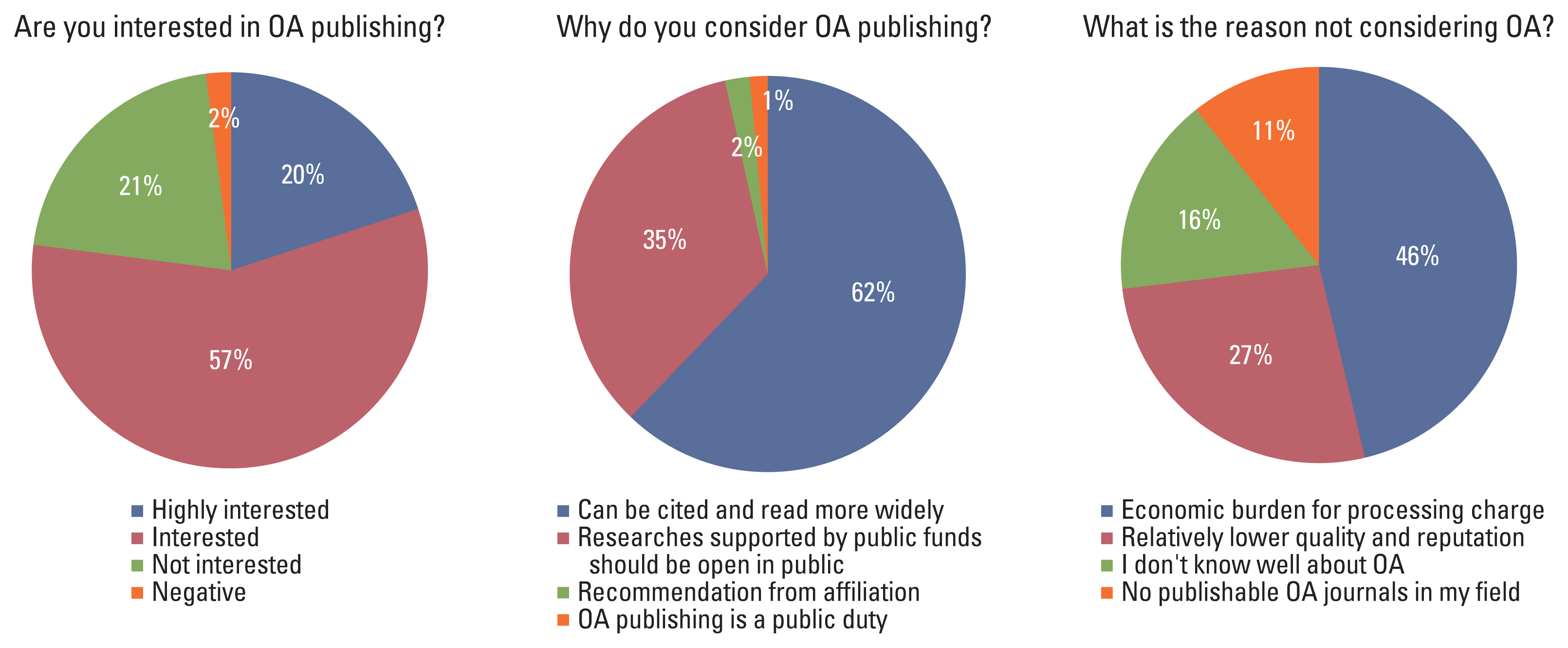Cancer Res Treat.
2021 Jan;53(1):1-8. 10.4143/crt.2020.816.
Practical Advice for South Korean Medical Researchers Regarding Open-Access and Predatory Journals
- Affiliations
-
- 1Department of Radiation Oncology, Korea University Medical College, Seoul, Korea
- 2Department of Radiation Oncology, Korea University Ansan Hospital, Ansan, Korea
- KMID: 2510642
- DOI: http://doi.org/10.4143/crt.2020.816
Abstract
- In recent decades, the volume of scholarly literature worldwide has increased significantly, and open-access publishing has become commonplace. These changes are even more dominant in South Korea. Comparing the periods of 1981-2000 and 2001-2020, the number of medical articles produced in Korea increased by 16.8 times on the Web of Science platform (13,223 to 222,771 papers). Before 1990, almost no open-access articles were produced in South Korea, but in the last 10 years open-access publications came to account for almost 40% of all South Korean publications on Web of Science. Along with the expansion of literature and the development of open-access publishing, predatory journals that seek profit without conducting quality assurance have appeared and undermined the academic corpus. In this rapidly changing environment, medical researchers have begun contemplating publication standards. In this article, recent trends in academic publishing are examined from international and South Korean perspectives, and the significance of open-access publishing and recent changes are discussed. Practical methods that can be used to select legitimate publishers, including open-access journals, and identify predatory journals are also discussed.
Keyword
Figure
Reference
-
References
1. Clarivate Analytics. Incites [Internet]. Philadelphia, PA: Clarivate Analytics;2020. [cited 2020 Aug 3]. Available from: https://incites.clarivate.com/#/explore/0/region?t=1596420925897 .2. Organisation for Economic Co-operation and Development. Health spending [Internet]. Paris: OECD;2020. [cited 2020 Aug 25]. Available from: https://data.oecd.org/healthres/health-spending.htm .3. Beall J. What I learned from predatory publishers. Biochem Med (Zagreb). 2017; 27:273–8.
Article4. Jeon CS. Progress of medical fee contract breakdown in 2009 and improvement plan. Healthcare Policy Forum. 2008; 6:32–40.5. Rim CH. A doctor who does not research is a half-doctor. Kyosu Shinmun;2020. Feb. 28.6. Suber P. An open access mandate for the National Institutes of Health. Open Med. 2008; 2:e39–41.7. Bill & Melinda Gates Foundation. Bill & Melinda Gates Foundation Open Access Policy [Internet]. Washington, DC: Bill & Melinda Gates Foundation;2020. [cited 2020 Jun 1]. Available from: https://www.gatesfoundation.org/How-We-Work/General-Information/Open-Access-Policy .8. European Commission. Open access [Internet]. Brussels: European Commission;2020. [cited 2020 Aug 5]. Available from: https://ec.europa.eu/research/openscience/index.cfm?pg=opena-ccess#:~:text=Open%20Access%20in%20Horizon%202020&text=All%20projects%20receiving%20Horizon%202020Model%20Grant%20Agreement .9. Kim HM. Survey on perception of Korean researchers regarding open access publishing. In : Proceedings of Korean Library and Information Science Society; 2018 Nov 23; Daejeon, Korea. Gongju: Korean Library and Information Science Society;2018. p. 183–9.10. Beall J. Criteria for determining predatory open-access publishers. 2nd ed. [Internet]. Denver, CO: Scholarly Open Access;2012. [cited 2020 Aug 5]. Available from: http://scholarlyoa.files.wordpress.com/2012/11/criteria-2012-2.pdf .11. Think, Check, Submit. Checklist to assess the journal or publisher [Internet]. Think.Check.Submit;2020. [cited 2020 Aug 5]. Available from: https://thinkchecksubmit.org/sample-page/check/ .12. Lee HK, Yang K. Comparative analysis of Korean universities’ journal publication research performance evaluation standards. J Korean Libr Inf Sci Soc. 2017; 48:295–322.13. Somoza-Fernandez M, Rodriguez-Gairin JM, Urbano C. Presence of alleged predatory journals in bibliographic databases: analysis of Beall’s list. Prof Inf. 2016; 25:730–7.14. Memon AR. Revisiting the Term Predatory Open Access Publishing. J Korean Med Sci. 2019; 34:e99.
Article15. Shen C, Bjork BC. ‘Predatory’ open access: a longitudinal study of article volumes and market characteristics. BMC Med. 2015; 13:230.
Article16. Beall J. Science magazine conducts sting operation on OA publishers. Scholarly Open Access. 2013. [cited 2013 Oct 12]. Available from: https://web.archive.org/web/20131012052-520/http://scholarlyoa.com/2013/10/03/science/ .17. Bohannon J. Who’s afraid of peer review? Science. 2013; 342:60–5.
Article18. Eisen M. I confess, I wrote the Arsenic DNA paper to expose flaws in peer-review at subscription-based journals. It is NOT junk: a blog about genomes, DNA, evolution, open science, baseball and other important things [Internet]. The Author;2013. [cited 2020 Aug 5]. Available from: http://www.michaeleisen.org/blog/?p=1439 .19. DOAJ. DOAJ’s response to the recent article in Science entitled “Who’s Afraid of Peer Review?”. DOAJ;2013. [cited 2020 Aug 28]. Available from: https://web.archive.org/web/2013-1023061516/http://www.doaj.org/doaj?func=news&nId=315&uiLanguage=en .20. Redhead C. OASPA’s second statement following the article in Science entitled ‘Who’s Afraid of Peer Review? Hague: Open Access Scholarly Publishers Association;2013.21. Laine C, Winker MA. Identifying predatory or pseudo-journals. Biochem Med (Zagreb). 2017; 27:285–91.
Article22. Sorokowski P, Kulczycki E, Sorokowska A, Pisanski K. Predatory journals recruit fake editor. Nature. 2017; 543:481–3.
Article23. Oh KS. A study on the publication of open access articles. J Korea Converg Soc. 2020; 11:145–51.24. Lee JW. A study of policy and agenda adoption trends of university library in Korea. J Korean Soc Libr Inf Sci. 2019; 53:83–99.
- Full Text Links
- Actions
-
Cited
- CITED
-
- Close
- Share
- Similar articles
-
- How To Cope With Predatory Journals
- Manuscript Submission Invitations from ‘Predatory Journals’: What Should Authors Do?
- Open Access Publishing in India: Coverage, Relevance, and Future Perspectives
- Dangerous Predatory Publishers Threaten Medical Research
- Pseudo-Journals and Pseudo-Conferences: the Characteristics and Preventive Measures



